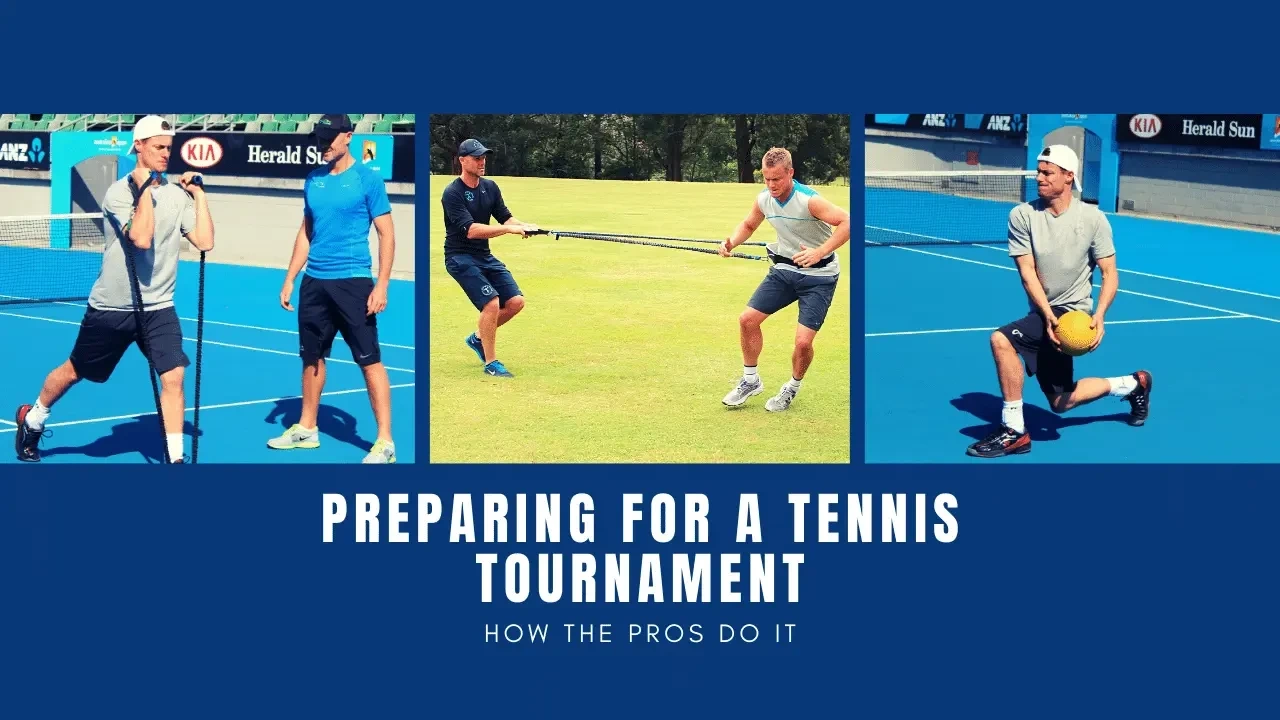Preparing For A Tennis Tournament, How The Pros Do It.
Feb 03, 2021
The greater tennis community is always blown away by the level of commitment, discipline and work that goes into preparing tennis professionals for competition. I truly believe the level of work that goes into the process would not be match by many other sports. It is really important for young aspiring players to understand what they need to build towards and how the journey is never straight forward. There are lots of twists and turns along the way, the main culprit being Tennis Injuries. That’s why so much of what we educate on is based on preventing tennis injuries. After 20 years of working as tennis strength and conditioning trainers, we feel we have a good idea of how it all works and what needs to happen.
In this blog, I wanted to give you an overview of how pro tennis players would prepare for what is called a “tournament swing”. This could involve 1-3 months on the road playing tournaments. How they prepare for this is extremely important. The training phase would generally be between 2-6 weeks during the playing season and 4-8 weeks in their preseason.
Preparing a player for multiple tournaments takes experience and skill, getting it right is not only important for a player’s short-term success but also critical for their longevity in the sport. Do too much and you can burn them out, if you don’t do enough, they will be underprepared and the results on the court won’t be great. Either way, if you get it wrong, the player is prone to injury and that is never what we want!
We figure our team has done close to 1000 tournament tennis preparation training phases for multiple players with an age range from 8 - 60 years. Most lasting 2-10 weeks. The majority of these have been working in the professional player space.
I want to discuss some key areas that the majority of pro players get right when preparing for a tournament swing. I am not saying every pro player follows these areas. These areas are compiled from our experience and our network of global tennis trainers. It is important to note that players tend to find their own way of doing things, what works for them is what they will run with. This generally works best when they have an experienced team around them to add and remove what is necessary from the programming.
I can tell you from experience it is really important to get the player involved in the planning and design of the training block, they need to buy into the process and also feel like they will be doing things that they feel work best for them. Finding what works best for an individual is important. There are a number of things to consider when doing this. A few examples include age, injury history, training experience, type of athlete (high intensity, slow-burner) someone that responds to high volume or low volume, the amount of motivation they like, do they like training with others, how robust they are (low threshold or high threshold).
An example of this would be working with Lleyton Hewitt and working with Casey Dellacqua at the same time. I did this for a period of time. Both great tennis athletes, but both very different training thresholds. The training phases were similar, but the actual sessions had to be different in intensity, workload, and exercise prescription. If I trained Casey like I trained Lleyton it would not have worked and vice versa. Lleyton responded best to high volume, high intensity, I usually had to slow him down. Lleyton loved the variety and doing more general training, especially early on in his training blocks. Casey worked very hard also, but her sessions were generally shorter in duration and more specific.
You never want to let a player totally dictate what happens in their training block, the key is getting them involved in the process and working out ways that allow you to achieve what you need to whilst incorporating their “wants” into the process. Where possible set the structure for the athlete, do not stick with the same structure for every athlete. We are all different and will respond better a specialized approach. This is challenging in group situations; however, things can still be tailored to suit player's needs better than a 1 shoe fits all approach, it just takes foresight and planning.
We use our “9 threads” as a template to follow when programming and within the training phases we can focus on certain aspects that we need to.
Preparing For A Tennis Tournament
So where do you start? Planning – Where it all begins.
Most players will sit down with their team and organize the training schedule. It is generally a team effort. Below is a list of 3 areas that generally get covered in this process.
- Have A Plan– What is the training plan? how long will it be, who is involved, where will sessions be carried out, what recovery protocols are you using, etc.
- Set Goals– What needs to accomplish over the training block? Injuries to work around or improve, specific areas to focus on e.g., reaction, serve power, endurance.
- Set Expectations – This is a process I have always enjoyed working through. When you discuss what your role is and how you are going to carry out your role, you then know what is expected of you and also what is expected of those around you. The expectation on the player is generally to communicate how they are feeling, mentally and physically, to make sure they are committing to every session and showing up on time. If those things are happening the training block usually runs smoothly.
Here is a general Daily Schedule for a Pro Players training block. They would do this 6 days a week, taking one day rest.
- Prepare the body; Foam Roller, Mobility, Warm-up. 45min
- Tennis Practice: Session structure varies depending on the training phase. Generally, between 2-3 hours.
- Rest/Recover; Cooldown, Ice bath, Stretch, Eat, Chillout. 2-3 hours.
- Tennis Fitness Training: Training structure varies depending on the training phase. Generally, between 1-2 hours.
- Tennis Practice: Depending on the training phase, they may have a shorter second session. Often practice sets or serve practice. 1-2 hours.
- Recovery: Cool down, Ice bath, Stretch, Eat, Massage, Sleep.
Do the math, most days players will exercise close to 5 hours, add in the warm-up and recovery protocols it is close to 8 hours on a daily basis. I know some people will be sitting there thinking I would not be complaining if that was me! What we need to consider is that we need to do this is year in and year out for years and years. Trust me it gets brutally challenging, physically and mentally. What happens behind the scenes is very different from what you see on television. The preparation is huge. That is why so few make it, the rest physically and mentally cannot get there.
What differentiates most pro players training blocks from the general tennis player or aspiring young player are these points below.
Tennis Training intensity – During these training blocks pro players work at a high intensity and high standard. This high level of tennis training intensity allows their body and mind to adapt to these demands and it is how they grow to become physically robust and mentally strong. If they are not exposing themselves to these situations, they will be well underprepared, no matter how good they are technically. Every pro player knows this and at some stage in their careers, they have decided to lift to a higher level of training and thinking. Even players like Bernard Tomic who often gets labeled with the “Lazy” tag works hard in phases, I have seen him work his butt off. One of my favorite sayings is “No one falls on top of the mountain” meaning no one gives anyone easy access to the pro level of tennis, it has to be earned through hard work and results – simple!
Backing up every day – When I worked with Lleyton Hewitt, I use to see many players come and train with him, after the first day we would see their energy drop and their intensity dwindle. Most of the time they were not doing the recovery and they had not exposed themselves to a high level of training on a consistent basis. Without gradual exposure to higher levels of training, you won’t develop physically, it’s impossible (remember that next time you step on the court or to train). Also doing all the extra work, recovery, hydration, nutrition, and rest. This is how you enable yourself to recover and back up every day.
Body Management - It is important to manage a player’s energy levels, injuries, training loads, sleep quality, and training quality. We do this using a training diary. A training diary is a way of tracking a player. I call it getting biofeedback. Most players are pretty crappy at doing this, so it is best to do it with them. We have developed our own online training diary. It covers areas such as; Sleep quality, Energy level, Training performance, Training duration, Hydration, Nutrition, Injury, and Illness. Players rate their results on a scale of 1-10. It generally takes 1min to get through and gives us incredible feedback on how things are moving and what needs to change. Most players will use something like this during a training block.
Maintain lifestyle balance – During heavy training blocks leading into a tournament swing, it is important for players to make sure they are keeping themselves mentally and emotionally balanced. Spending time doing things away from tennis is important. Being around family and friends and doing things that distract them from the pressures of tennis and training helps them switch off their tennis head and gives them the chance to work on other areas of their lives. Like anything that we focus too much time and attention on it can give us the sense that it is everything and with that can come a mass amount of pressure. Finding the balance in lifestyle is important for anyone and especially for the aspiring young player. The more balanced and connected to other positive things they are the more rounded and confident they will become.
If you need help preparing your body for tennis and you want to get to a higher level of play. I recommend you try one of our Online Tennis Fitness Programs. We have various programs to cater to different ages and levels of play. Get your own training block going!
I hope that gives some perspective on what preparing for a tournament swing looks like for a tennis professional. There is not just one thing you need to get right. There are a number of areas that need to be functioning well in order to reach your optimal tennis self.
What you can do no matter the environment or situation is to give everything you have. Like Raffa always says “I’m just going to go into every situation and give my best and try everything I can to get the best outcome” simple and super effective.
Magic happens when you adopt this mindset!
Good luck!


